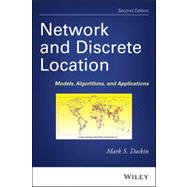Praise for the First Edition
This book is refreshing to read since it takes an important topic...
and presents it in a clear and concise manner by using examples that include visual presentations of the problem, solution methods, and results along with an explanation of the mathematical and procedural steps required to model the problem and work through to a solution.” —Journal of Classification
Thoroughly updated and revised, Network and Discrete Location: Models, Algorithms, and Applications, Second Edition remains the go-to guide on facility location modeling. The book offers a unique introduction to methodological tools for solving location models and provides insight into when each approach is useful and what information can be obtained.
The Second Edition focuses on real-world extensions of the basic models used in locating facilities, including production and distribution systems, location-inventory models, and defender-interdictor problems. A unique taxonomy of location problems and models is also presented. Featuring examples using the author’s own software—SITATION, MOD-DIST, and MENU-OKF—as well as Microsoft Office® Excel®, the book provides:
• A theoretical and applied perspective on location models and algorithms
• An intuitive presentation of the uses and limits of modeling techniques
• An introduction to integrated location-inventory modeling and defender-interdictor models for the design of reliable facility location systems
• A full range of exercises to equip readers with an understanding of the basic facility location model types
Network and Discrete Location: Models, Algorithms, and Applications, Second Edition is an essential resource for practitioners in applied and discrete mathematics, operations research, industrial engineering, and quantitative geography. The book is also a useful textbook for upper-level undergraduate, graduate, and MBA courses.








